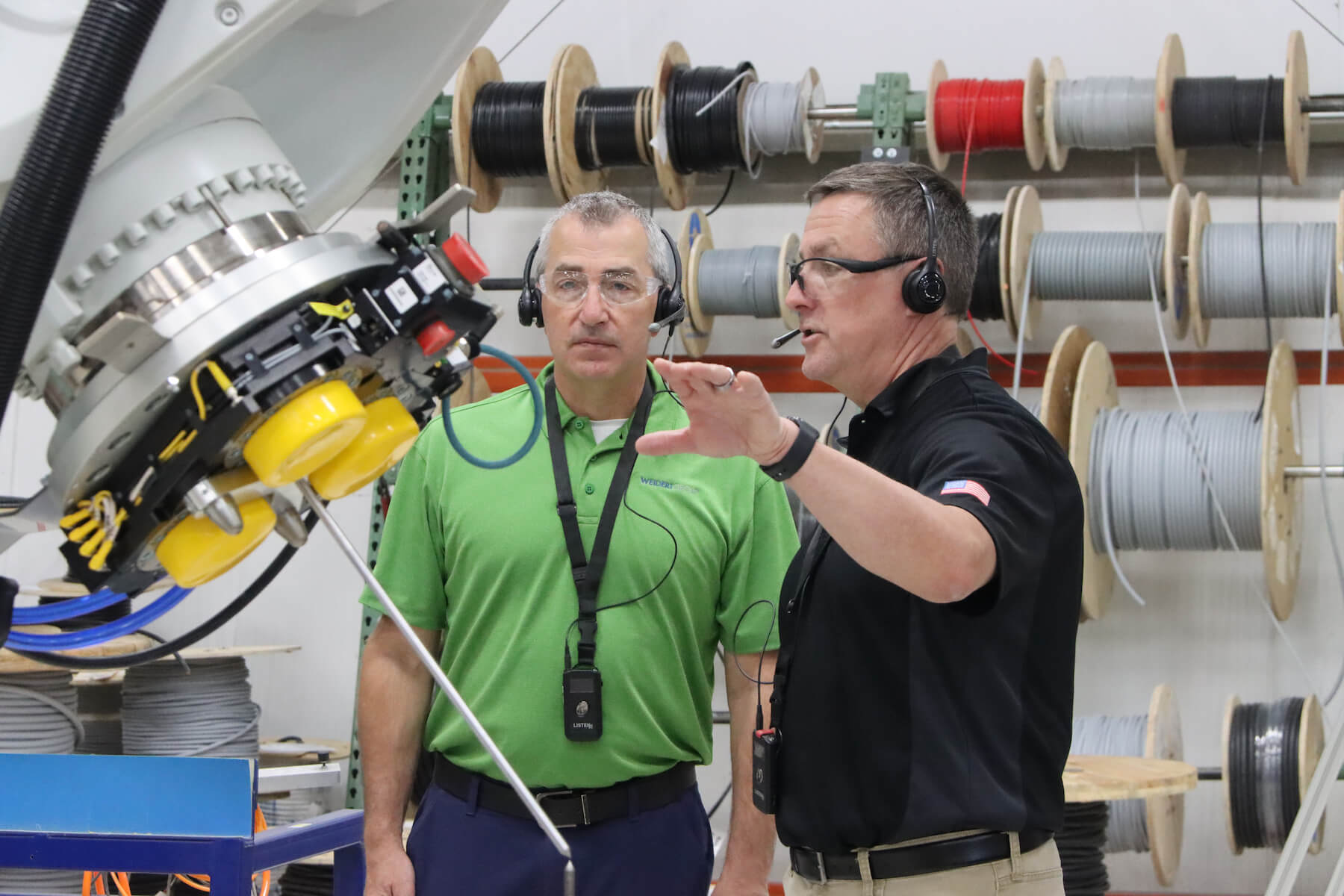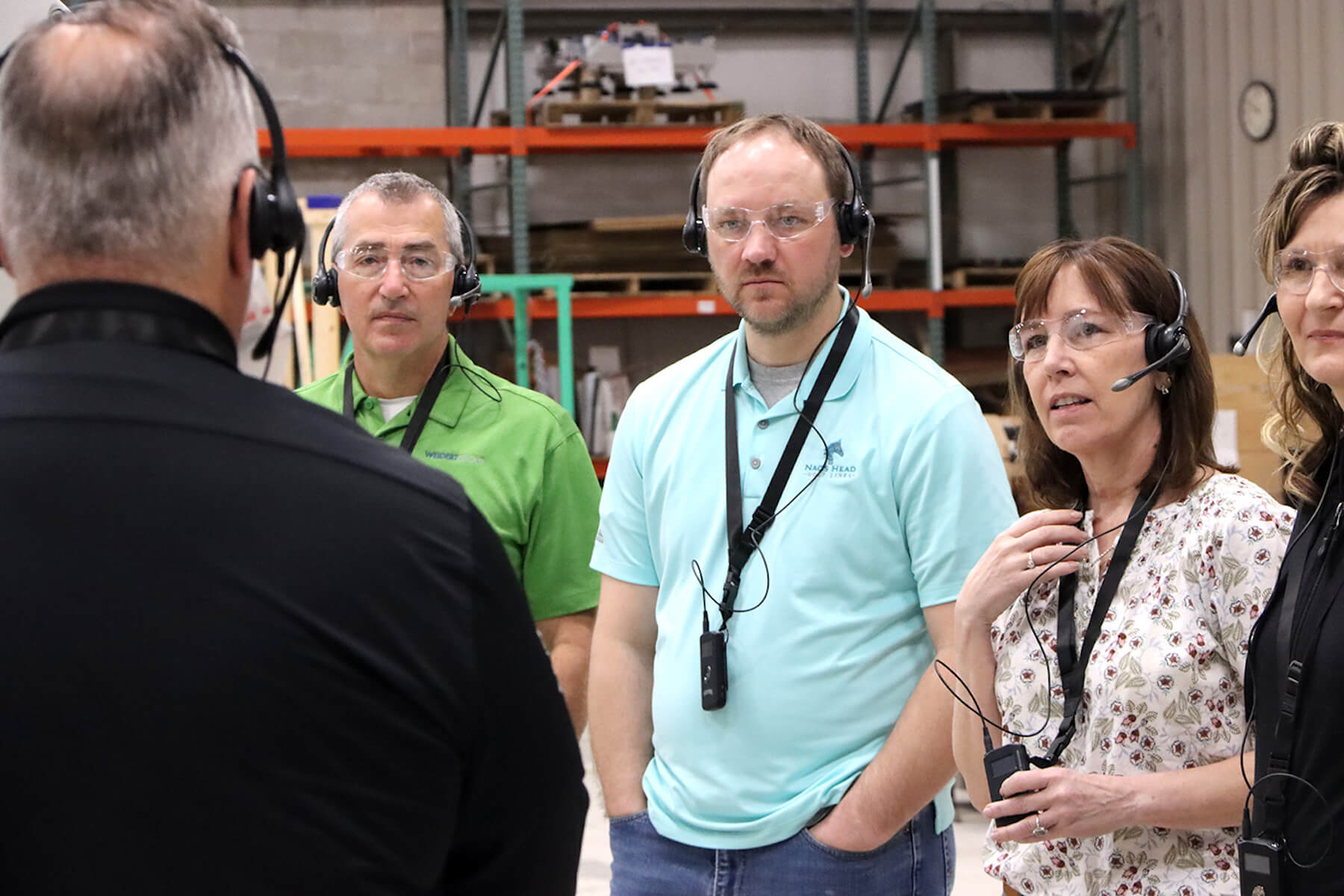An Easy-to-Understand Primer of Tour Guide System Components
When I talk with an event planner or facility tour manager about the challenges they’d like their tour guide system to solve, they’re often surprised at how many features and options there are.
As new tour guide systems become available, audio solutions providers are adding capabilities that might not be on your radar. Do you need all the bells and whistles? Or will a basic system meet your needs?
To help you better understand the features and why you might or might not need them, I’ve put together this list of tour guide system components.
RELATED: How Does Your Tour Rank? Use Our Tour Grading Tool
Tour Guide Equipment
Transmitters — One-Way Communication
Every tour guide system includes a transmitter to broadcast the presenter’s voice to the tour participants' receivers, allowing them to hear clearly. Transmitters are lightweight and portable and can be configured wirelessly or via AUX audio input depending on the system.
Transceivers — Two-Way Communication
Some tour guide technologies combine the transmitter and receiver into a single unit called a transceiver. This technology is ideal for tour guides who wish to create a more interactive experience with two-way communication. Presenters can ask questions, interact with guests, and invite them to respond with the push of a button.
RELATED: The Best Tour Guide Systems with Transceivers
Microphones & Headphones
Microphones come in two styles: headset or handheld.
Headset microphones are great for tours that require hands-free demonstrations. They come in a variety of options including lightweight, hard-hat compatible, single-ear or dual-ear headsets, protective ear muffs or earbuds. Headset microphones incorporate headphones for two-way systems.
A wireless handheld microphone is ideal for tours where the presenter wants to pass the microphone to other presenters or guests for questions and answers. The presenter also wears headphones to hear the comments and questions from the audience.
Tour Guest Equipment
Receivers or Transceivers
Receivers are integrated into the headset device worn by tour participants or may be attached via a small, lightweight pack worn on a lanyard around the neck or clipped to a belt. The receiver picks up the signal from the transmitter and converts it to sound. A transceiver allows the guest to receive and send for an interactive conversation with the tour guide.
Headsets
A headset delivers the audio signal from the receiver to the user’s ears. Headsets can come in various styles and will need a microphone for two-way systems. Some headsets include a receiver so only one piece of equipment is needed.
- Earbuds
- Over-ear Headsets with single- and dual-ear coverage options
- Wireless Receiver Headset — This all-in-one headset does not need a separate receiver and offers exceptional sound clarity, quality and comfort.
- NRR-compliant headsets — Noisy environments like factories and industrial facilities may require hearing protection for those exposed to high decibel levels over long periods of time. Providing noise reduction rating (NRR) headsets enhances safety and is a courtesy to guests, ensuring they hear every word. These headsets come as earbuds or earmuffs that can be worn over the head or with hardhats.
- Bone Conduction Receivers — Another all-in-one headset, this cutting-edge technology is ideal for loud environments. Instead of being worn over the ear, the receiver rests on the user’s cheekbones just in front of the ear and conducts sound through vibrations. Tour guests can wear safety earplugs and hard hats and still hear the message clearly.
Additional Tour Guide System Options To Consider
Language Interpretation Mode
Many events have international guests, and it’s frustrating for everyone when they can’t understand your important message due to language barriers. Tour guide systems like ListenTALK and Williams AV feature a special mode for language interpretation, allowing a translator to convey the message to a foreign guest on a separate channel.
Bluetooth Transmitters
Tour operators who want to enhance their guest experiences with music or audio from their phone or mobile device can pair their tour guide transmitter using Bluetooth. Not all systems feature Bluetooth, however, so if this is something you feel will add value, be sure to ask about which systems come equipped.
Handheld Wireless Speakers
Handheld wireless speakers help amplify your message with clear audio, acting as a small PA system. They’re great for boosting your message at events that can tend to be noisy, like outdoor festivals and conferences. These portable speakers can be integrated into an existing setup with Bluetooth capabilities, and multiple speakers can be synched to cover larger areas.
Noise-Canceling Technology
Headsets with noise-canceling technology are ideal for tours conducted in areas with a lot of ambient noise, like factory floors or convention halls. The feature reduces background noise, helping to minimize disruptions and deliver clearer audio.
Multi-Channel Capability
Some types of events conduct multiple tours at a time. To do this, each group needs to be assigned a different channel to eliminate interference or cross-talk. Most wireless tour guide systems offer multiple channels with some having as many as 25. There are companies, however, who only conduct single tours and never go beyond a single channel. It’s nice to know you have the option should the need arise, however.
Charging Stations
The function of charging stations is obvious — to recharge batteries in the transmitters and receivers. The design of the charging station, however, can differ. Ideally, you want a docking station that allows you to simply seat each unit into a base. Charging times will vary as well, so if you need a quick turnaround, ask your provider how long it takes to recharge a system.
Batteries
Just as important as the charging station are the batteries being charged. Battery life can vary greatly between systems. Some may last eight hours whereas others with lithium-ion batteries may give you 20 hours of operating power. If you have an all-day event like a tradeshow or festival, be sure to check the system’s specifications to ensure your batteries won’t run out of juice part-way through your presentations. When you rent from Implecho, batteries arrive fully charged and the system is ready to use out of the box.
Privacy Features
Some tour guide systems offer encryption technology to make sure your conversations stay private — useful for government, courts and facility tours or presentations showcasing proprietary technology or information.
NFC Technology
Near Field Communication (NFC) Technology is another optional feature that helps provide quick and easy device pairing so that a single system can reach throughout a facility. This is great for tours where a group is “handed off” to a second tour guide while the original guide begins hosting another group.
Tour Guide System Controls
As far as the units themselves, participants can expect their own volume control to set audio levels to their preferences. The tour guide can also mute their own device as well as their guests’ control settings in the case of two-way systems. This helps ensure that their message isn’t interrupted by side conversations. Yet, they can easily unmute participants’ headsets when it comes time for Q&A sessions. Other controls might include a push-to-talk button and controls for mic sensitivity.
Rent, Buy & Demo Options
Not all audio solutions providers offer the option to rent, purchase or demo a tour guide system. While not a feature of a system itself, it’s important to consider based on how often you’ll use your tour guide system. Events held once or twice a year probably warrant renting whereas those who conduct frequent tours may be better suited toward owning a fleet. There are always exceptions, though.
No matter which scenario, it’s a good idea to request a demo to ensure the system you choose will fit your needs. We know, however, that configuring the right system and weeding through all the options can be confusing. Just know that I and other audio solutions experts are here to help. We know the questions to ask and enjoy guiding you toward a just-right solution. Reach out to us. It’s our job to make it easy.
If you conduct tours and want to know whether they could use some improvement, check out our interactive Facility Tour Evaluation Tool below. It can give you additional ideas and insights.
You May Also Like
These Related Stories
How Does a Tour Guide System Work?
If you routinely conduct guided tours on a factory floor or in other noisy ......
What is a Transceiver on a Tour Guide System?
Two-way tour guide systems serve two functions: They allow a presenter to ......
Why Use the ListenTALK Tour Guide System for Factory Tours
A factory floor can be loud, sometimes exceeding 90 decibels – that’s about as ......
We're Here to Help Guide You




